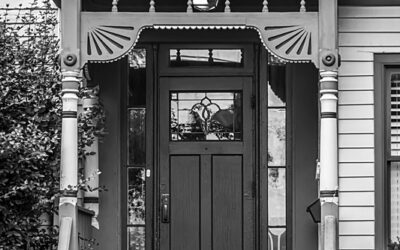These two brightly colored sculpted heads stand on stainless-steel tables in front of the Earl V. Moore building on Baits Dr. Though they look utterly modern, a plaque at their base discloses that beneath the enamel paint, the heads are made of bronze. They were cast in a foundry in Washington state using the lost-wax process, which dates back to 3,700 B.C.
The heads’ creator, Jun Kaneko, was born in Japan and moved to the United States when he was twenty-one. Western influences predominate in his work, but one of his sources of inspiration is the centuries-old Zen rock garden at Ryoan-ji (the Temple of the Dragon at Peace) in Kyoto. The rock garden, like Kaneko’s own works, has a sense of mystery, inviting viewers to make of it what they will.
Based in Omaha, Kaneko is primarily a ceramicist, but in addition to bronze, he has also worked in painting, drawing, textiles, and glass; he’s even designed sets and costumes for operas.
Kaneko has created head statues in both bronze and clay. When we asked his studio why he chose bronze for this piece, titled “Impressions,” we were told that he likes working in new mediums and new ways. Kaneko, a lifelong iconoclast, made the bronze heads during a residency of several months at the Walla Walla Foundry. (Their website, WallaWallaFoundry.com, is worth a look.) After Kaneko created the heads in plaster, they were cast in Endur silicon bronze, a modern commercial alloy, 94-95 percent copper, plus silicon and a small amount of manganese. He then applied the enamel paints back at his studio.
Like many of Kaneko’s pieces, the heads are monumental. In an artist statement, he explains: “I think the most successful piece has the ability to pull the viewer right into it, to such an extent that there is no perceptible space between the viewer and the viewed object. … I like to have the idea of spiritual power in the scale so it will overcome conventional scale. If I am pulled into the piece, I will forget about scale and that is a really strong spiritual kind of power.”
The statues were the gift of the Clarence Leslie Roy and Ruth Mildred Roy Trust. Clarence Roy, who died in 2000, co-founded landscape architects Johnson, Johnson and Roy in Ann Arbor, which merged with SmithGroup architects to become SmithGroupJJR, one of the largest architecture, engineering, and planning firms in the country. Ruth Roy, who died in 2008, was a talented interior designer. Purchased by the trust after Ruth’s death, “Impressions” was installed in 2013.
The studio does not have any record of how the title came about. Most of Kaneko’s work is untitled; he prefers the viewer to have a natural reaction to the work, rather than one informed by an explanation.
North Campus is a bit out of the way for those not attending or teaching there. But a pilgrimage to see the colorful bronze heads can be rewarding, emotionally engaging–and perhaps even a spiritual experience.





There is an identical piece in Shanghai, China near the Pearl Tower. I had thought these ‘Talking Heads’ just marked music schools. PS: I just sent the photo to the editor, that I took of our last China-trip.